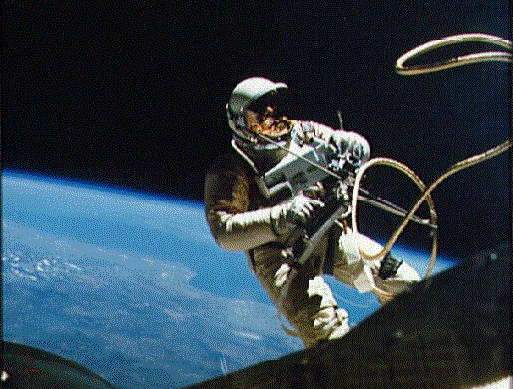Astronauts patched a damaged solar panel on the international space station yesterday during a tricky and dangerous seven-hour spacewalk.
Perched on the tip of an extension of the station's long robotic arm, astronaut Scott E. Parazynski snipped off tangles of broken and frayed wires that had ripped open two spots on the huge solar array, and installed five jury-rigged straps to reinforce the damaged area, allowing the panel to finally unfurl fully.
In this image provided by NASA television astronaut Scott Parazynski, top, gets into the foot restraints with the assistance of astronaut Douglas Wheelock at the end of the 90-foot robotic arm and boom extension, center, which will carry Parazynski for a 45-minute ride to the damage site at the start of the space walk to repair the damaged solar array Saturday Nov. 3, 2007.
"Excellent work, guys, excellent," space station commander Peggy A. Whitson said after the tense, painstaking job was finally done.
The spacewalk was considered particularly risky, with Parazynski venturing farther from the safety of the station than ever before. The repairs were unusually complicated because the astronauts were unable to fully assess the damage before getting close to the array and had to hope that their quickly improvised repair plans would work. Normally, such a repair mission would take weeks or even months of preparation and rehearsal.
But without the repairs, the damaged solar wing could have become structurally unstable, posing a hazard to the outpost and requiring that it be jettisoned.
Without the panel, the station would not have enough power to continue expanding. That could have forced a postponement of the installation of the next component, a European laboratory, next month. NASA is under pressure to complete the construction of the station before it retires the aging space shuttle fleet in 2010.
So, wearing protective spacesuits, Parazynski and astronaut Douglas H. Wheelock ventured out of the station, orbiting about 213 miles above the East Coast, just past 6 a.m. to begin the unprecedented job.
"Go out there and fix that thing for us," Whitson radioed just before the pair left the safety of the station's airlock.
With Wheelock positioned at the base of the solar array, Parazynski anchored his feet to the end of a 50-foot boom from the space shuttle; the boom was grasped in the middle by the station's 58-foot robotic arm. The arm carried him on a slow-motion, 45-minute trip half a football field away to just barely reach the damaged panel.
Dramatic live-television images showed Parazynski atop the extended arm with the bright orange solar array behind him and the brilliant blue and white Earth below.
Once there, Parazynski, an emergency-room physician, assessed the full extent of the damage for the first time, describing a daunting "hairball" of tangled wires in the area that was mangled when the solar panel was deployed Tuesday. The panel suffered two tears; the largest was about 2 1/2 feet long.
All the tools and all the metal parts of Parazynski's spacesuit were wrapped with insulating tape to minimize the risk of the astronaut getting shocked by the electric array, which is generating 160 volts. His bulky gloves were also covered with extra mittens for added protection.
Using an L-shaped device, dubbed a "hockey stick," to periodically and gently nudge the array away, as well as needle-nose pliers, vice-grips and clippers to cut away and secure loose wires, Parazynski methodically completed the repair, radioing his colleagues each step of the way.
Parazynski, one of the most experienced spacewalkers, installed five "cuff links," which the astronauts had pieced together from spare parts aboard the station. The three- to five-foot long pieces are insulated cables with aluminum plates at each end that Parazynski slipped into holes in the array like cuff links into a shirt sleeve. They are designed to support the damaged area and prevent further tearing.
Once all five were installed, Parazynski and Wheelock watched closely as ground controllers slowly unfurled the solar panel to its full 110-foot length. Parazynski then rode the robotic arm back to safety, returning inside the station with Wheelock at 1:22 p.m.
"It certainly was a really good day overall," said Dina Contella, lead spacewalk officer, during a briefing afterward.
The torn array, however, is just one of the problems facing the station. Metal shavings were discovered earlier in a joint on the station, jamming control of the solar arrays on that side. Space station managers are trying to determine how to fix that malfunction.

 Cynthia Beall studies adaptation to high altitudes. (Credit: Image courtesy of Case Western Reserve University)
Cynthia Beall studies adaptation to high altitudes. (Credit: Image courtesy of Case Western Reserve University) Analyzing the mix of hydrogen, oxygen and noble gases found in the sun can answer one of the biggest questions of the universe: How did our solar system evolve? (Credit: iStockphoto/Alexander Hafemann)
Analyzing the mix of hydrogen, oxygen and noble gases found in the sun can answer one of the biggest questions of the universe: How did our solar system evolve? (Credit: iStockphoto/Alexander Hafemann) Hackers have launched a rare and troubling attack on
Hackers have launched a rare and troubling attack on  Most anti-ballistic materials, like bullet-proof jackets and explosion-proof blankets, are currently made of multiple layers of Kevlar, Twaron or Dyneema fibres which stop bullets from penetrating by spreading the bullet's force. Targets can still be left suffering blunt force trauma - perhaps severe bruising or, worse, damage to critical organs.
Most anti-ballistic materials, like bullet-proof jackets and explosion-proof blankets, are currently made of multiple layers of Kevlar, Twaron or Dyneema fibres which stop bullets from penetrating by spreading the bullet's force. Targets can still be left suffering blunt force trauma - perhaps severe bruising or, worse, damage to critical organs. The average chicken farmer does not have enough chemicals to make his farm a terrorist target, but many fertilizer wholesalers and paper mills do - and they'll have to tell the government about it as part of new anti-terrorism measures.
The average chicken farmer does not have enough chemicals to make his farm a terrorist target, but many fertilizer wholesalers and paper mills do - and they'll have to tell the government about it as part of new anti-terrorism measures. (
(

 How brain acts for crealtivity ?
How brain acts for crealtivity ? Researcher is finding the source of energy - fuel of Alternative way .....
Researcher is finding the source of energy - fuel of Alternative way .....

 Professor Natasha Neogi with some of the remote-controlled aircraft used to simulate air traffic.
Professor Natasha Neogi with some of the remote-controlled aircraft used to simulate air traffic. A team of researchers led by Jiang He, Professor of Epidemiology at the Tulane University School of Public Health and Tropical Medicine, examined the association between cigarette smoking and erectile dysfunction in a 2000-2001 study in China involving 7,684 men. The researchers used questionnaires to assess the status of cigarette smoking and erectile dysfunction. Those surveyed were men between the ages of 35-74 who did not have vascular disease.
A team of researchers led by Jiang He, Professor of Epidemiology at the Tulane University School of Public Health and Tropical Medicine, examined the association between cigarette smoking and erectile dysfunction in a 2000-2001 study in China involving 7,684 men. The researchers used questionnaires to assess the status of cigarette smoking and erectile dysfunction. Those surveyed were men between the ages of 35-74 who did not have vascular disease.
 A small region of a mutant mouse brain magnified 1000X. In the normal tissue the cells are tightly packed with no gaps, but in the mutant there are large holes due to loss of neurons from absence of the molecule PI(3,5)P2 from suppression of the Vac14 gene. (Credit: Image courtesy of University of Michigan)
A small region of a mutant mouse brain magnified 1000X. In the normal tissue the cells are tightly packed with no gaps, but in the mutant there are large holes due to loss of neurons from absence of the molecule PI(3,5)P2 from suppression of the Vac14 gene. (Credit: Image courtesy of University of Michigan) This image provided by NASA television shows the hatch opened on the Quest airlock and astronaut Scott Parazynski waiting to exit on the second space walk of the mission early Sunday Oct. 28, 2007. (AP Photo/NASA
This image provided by NASA television shows the hatch opened on the Quest airlock and astronaut Scott Parazynski waiting to exit on the second space walk of the mission early Sunday Oct. 28, 2007. (AP Photo/NASA Armadillo's MOD Meets with Limited Success on Day 1 of Lunar Challenge.
Armadillo's MOD Meets with Limited Success on Day 1 of Lunar Challenge. :RFID technology is used widely in the public and private sector to assist businesses with asset tracking and security. Hospitals use RFID equipped bracelets and patches to track newborn movements, prevent accidental switching of infants, reduce prescription medicine and surgical errors, and monitor the location of equipment. Public transportation systems worldwide use RFID equipped cards to track and bill use of the services, such as "EZ Pass" type equipment for toll roads or payment cards for mass transit systems. Corporations and schools use RFID chips in identification cards to control access to restricted areas. Many cars have RFID chips in their ignition keys, and keyless ignition works because of the technology as well.
:RFID technology is used widely in the public and private sector to assist businesses with asset tracking and security. Hospitals use RFID equipped bracelets and patches to track newborn movements, prevent accidental switching of infants, reduce prescription medicine and surgical errors, and monitor the location of equipment. Public transportation systems worldwide use RFID equipped cards to track and bill use of the services, such as "EZ Pass" type equipment for toll roads or payment cards for mass transit systems. Corporations and schools use RFID chips in identification cards to control access to restricted areas. Many cars have RFID chips in their ignition keys, and keyless ignition works because of the technology as well.
